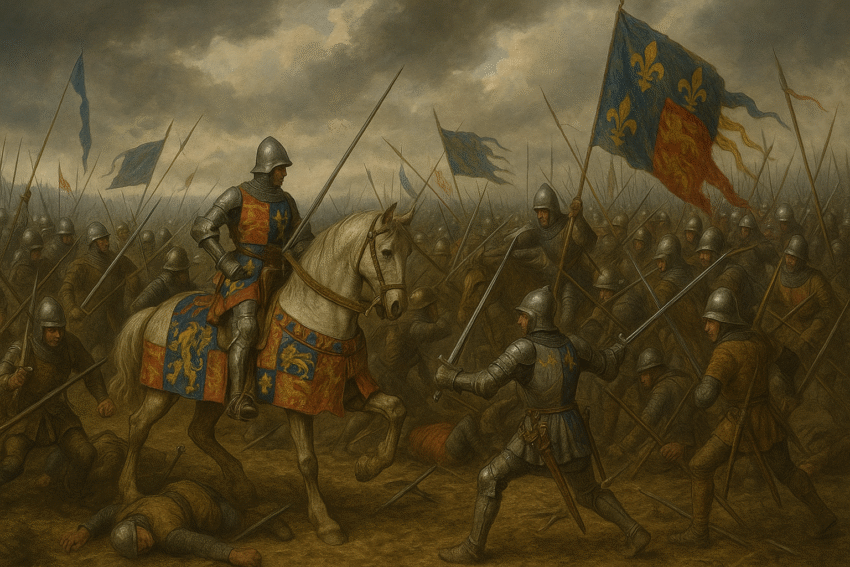V chladném a deštivém ránu 25. října 1415, na svátek sv. Kryštofa, došlo v severní Francii k jedné z nejikoničtějších bitev středověké Evropy. Bitva u Azincourtu (fr. Agincourt) se stala symbolem anglického vojenského důvtipu, houževnatosti a převahy lukostřelců nad početní přesilou těžkooděnců. Přestože Angličané čelili značné francouzské převaze, díky taktice, terénu a technologii dokázali zvítězit – a to tak drtivě, že jejich vítězství otřáslo celou Francií.
🗺️ Kontext bitvy: Stoletá válka a tažení Jindřicha V.
Stoletá válka (1337–1453) byla sérií konfliktů mezi Anglií a Francií o nárok na francouzský trůn. V roce 1415 se mladý anglický král Jindřich V. rozhodl obnovit anglické nároky a vpadl s armádou do severní Francie. Po obléhání a dobytí přístavu Harfleur se jeho vojsko, vyčerpané nemocemi a únavou, vydalo na pochod směrem k Calais. Francouzská armáda, mnohonásobně silnější, mu zatarasila cestu nedaleko vesnice Azincourt.
👑 Hlavní postavy:
-
Jindřich V. Anglický – mladý král, charismatický vůdce, který osobně vedl vojáky do boje
-
Charles d’Albret – francouzský vrchní velitel, jehož vedení bylo omezeno šlechtickými rozpory
-
Jean le Maingre (Boucicaut) – slavný francouzský rytíř, symbol tradičního rytířství
Zajímavost: V Jindřichově vojsku bojoval i slavný William Shakespeare – tedy postava, kterou v jeho stejnojmenné hře ztvárnil král Jindřich jako vůdce vojska.
🎯 Průběh bitvy a taktika:
Angličané zaujali pozici mezi dvěma lesy, čímž znemožnili Francouzům rozsáhlejší manévrování.
✅ Postavení lukostřelců – ti tvořili asi 80 % armády. Byli chráněni za dřevěnými kůly zapíchnutými do země, tzv. „palissady“.
✅ Terén – rozbahněná pole po deštích zpomalila těžkooděnce, kteří se stali snadným cílem.
✅ Taktika – Angličané vyprovokovali Francouze k útoku, a poté je rozstříleli z dálky. Jakmile se rytíři přiblížili, byli zpomaleni bahnem a tísněním – a dobiti v boji zblízka.
Zajímavost: Anglické dlouhé luky měly dostřel přes 250 metrů a pronikaly i plátovou zbrojí.
🔍 Výsledek a důsledky:
Francouzi ztratili až 7 000 mužů, včetně mnoha šlechticů. Angličané přišli přibližně o 400–600 vojáků.
📌 Vítězství Jindřicha V. upevnilo jeho postavení doma i v Evropě.
📌 Francouzská morálka byla těžce otřesena. Bitva ukázala slabiny rytířské taktiky a význam pěchoty a střelců.
📌 V roce 1420 byla podepsána Troyeská smlouva, podle které se Jindřich stal dědicem francouzského trůnu.
⚠️ Méně známá fakta a zajímavosti:
-
Mnoho zajatých francouzských šlechticů bylo po bitvě popravováno – Jindřich se obával protiútoku a nedostatku vojáků pro jejich hlídání.
-
Bitva u Azincourtu inspirovala Shakespeara k napsání slavné hry Jindřich V., jejíž řeč před bitvou – „We few, we happy few, we band of brothers“ – se stala ikonickou.
🏁 Závěr:
Bitva u Azincourtu je dodnes symbolem toho, jak strategie, morálka a technologie mohou překonat početní převahu. Ukázala konec dominance rytířské jízdy a začátek modernějšího způsobu válčení. Pro Anglii znamenala triumf a pro Francii hořkou lekci – že války se nevyhrávají jen urozeným původem, ale hlavně hlavou a odhodláním. A to je lekce, která přetrvala věky.
